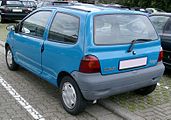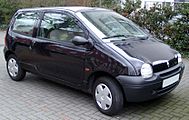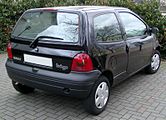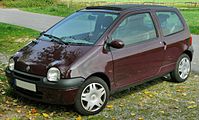Renault Twingo
| Renault Twingo | |
|---|---|
 | |
| Overview | |
| Manufacturer | Renault |
| Production | 1992–present |
| Body and chassis | |
| Class | City car |
| Body style | 3-door hatchback (Twingo I and II) 5-door hatchback (Twingo III) |
| Layout | Front-engine, front-wheel-drive (Twingo I and II) Rear-engine, rear-wheel-drive (Twingo III) |
| Chronology | |
| Predecessor | Renault 4 |
The Renault Twingo is a four passenger city car manufactured and marketed by the French automaker Renault, introduced in 1992 and currently in its third generation.
The first generation Twingo (two door, front engine) debuted at the Paris Motor Show on 5 October 1992, receiving its formal market launch in continental European markets beginning in April 1993. Renault launched the second-generation Twingo (two door, front engine) in the summer of 2007 — and the third generation (four door, rear engine) debuted at the 2014 Geneva Motor Show, receiving its formal market launch in September 2014.
Twingo is a portmanteau of the words twist, swing and tango.[1]
Twingo I (1993–2007)
| Twingo I | |
|---|---|
 | |
| Overview | |
| Production | 1992–2007 (France) 1994–2003 (Spain) 1999–2002 (Uruguay) 1995–2012 (Colombia) |
| Assembly |
|
| Designer | Patrick le Quément |
| Body and chassis | |
| Body style | 3-door hatchback |
| Layout | Front-engine, front-wheel-drive |
| Powertrain | |
| Engine | 1.0 L D7D I4 (petrol) 1.2 L C3G I4 (petrol) 1.2 L D7F I4 (petrol) 1.2 L D4F I4 (petrol) |
| Transmission | 5-speed manual 5-speed semi-automatic 3-speed automatic |
| Dimensions | |
| Wheelbase | 2,345 mm (92.3 in) |
| Length | 3,430 mm (135.0 in) |
| Width | 1,630 mm (64.2 in) |
| Height | 1,420 mm (55.9 in) |
| Curb weight | from 790 kg (1,742 lb) |
The original Twingo was launched in April 1993, was sold in Europe's LHD markets until August 2007, and received intermediate restylings in 1998, 2000 and 2004. It was never sold in RHD markets.
Development
Designed under the direction of Patrick Le Quément, Renault's chief designer.[2] The car derived from a series of concepts developed through the W60 project when Gaston Juchet was Renault's chief designer. The project was aimed at replacing the Renault 4 with a minivan model.[2]
Le Quément chose a Jean-Pierre Ploué design to develop the production version. He included an unconventional front end layout resembling a "smile." The interior equipment was mounted on a central console to free space.[3] Renault had participated in the 1981 to 1984 'Mono-Box' ECO 2000 car project, along with PSA Peugeot Citroën and the French Government.[4]
The Twingo I's electronic centrally mounted instrument panel had a speedometer, fuel gauge, clock, odometer and trip recorder controlled via a stalk located button. A strip of warning lights was located behind the steering wheel. The rear seat featured a sliding mechanism, to enable either increased boot space or rear seat legroom. The boot parcel shelf was attached to the inside of the tailgate, and lifted with the tailgate — or could clip back against the rear window when not required.
Engines
All engines were replaced with an 8 valve 1.15 litre 60 hp (45 kW) unit. A 16 valve 75 hp (56 kW) version was added in 2000.
Manufactured at the Flins Renault Factory from the time of its launch until 28 June 2007, the Twingo I was also manufactured in Taiwan, Spain, Colombia and Uruguay from 1999 to 2002,[5] remaining in production into 2012 in Colombia, by the Sofasa conglomerate, strictly for the South American market.
- Twingo I Safety
EuroNCAP results:
- Adult Occupant:




 , score 23
, score 23 - Pedestrian:



 , score 11
, score 11
Timeline
This section needs additional citations for verification. (April 2014) |
In April 1993, the Twingo launched with only one trim level, and four exterior colours: coral red, Indian yellow, coriander green and overseas blue. The car retailed at a price of 55,000FF (approximately $19,000, 2018). In June 1994, new exterior colours were introduced along with minor interior changes, as well as optional power windows, locks with remote keyless entry, and mirrors. Four months later, the Twingo Easy model was launched, with a semi automatic gearbox.
In September 1995, the first of many special Twingo editions launched, while in built airbags become optional. In July 1996, a new 1149 cc engine (from the Clio) was fitted to replace the previous engine from the Renault 5. Alongside the new engine came the Twingo Matic model, equipped with a 3-speed automatic gearbox. Also, various improvements were made including the addition of a third brake light.
Two years later, the Twingo underwent its first major restyling revisions to the interior and dashboard. The front and rear lights were revised, and front orange indicator lights were merged into the headlamp housing. Two months later, the top of the range Twingo Initiale model launched.
In September 2000, the Twingo underwent its second major restyling. Additions included larger 14" wheels, revised door trims with larger door pockets, a black trunk opener lever (instead of shiny silver) and cup holders in front of the gearstick.
December 2000, a new 1.2 litre 16v engine launched, with 75 hp (56 kW). In April 2001, a new semi automatic gearbox launched, called Quickshift. Additional revisions followed in September 2002, including new interior trims and wheel covers.
In Japan, Renault was formerly licensed by Yanase Co., Ltd., but in 1999, Renault purchased a stake in Japanese automaker Nissan after Nissan had faced financial troubles following the collapse of the Japanese asset price bubble in 1991 and subsequent Lost Decade. As a result of Renault's purchase of interest, Yanase canceled its licensing contract with Renault in the spring of 2000, and Nissan Motor Co., Ltd took over as the sole licensee, hence sales of the Twingo I in Japan were transferred from Yanase Store locations to Nissan Red Stage Store locations.
September 2004 marked the third major Twingo revision. The Renault logo was fitted to the boot lid, side rubbing strips were added and a new range of exterior colours launched. On 28 June 2007, Twingo I production ended in France, being replaced by the Twingo II. On 30 June 2007 2,478,648 units from the Twingo I were produced. The Renault Twingo I production went on into Colombia until 8 June 2012. In total there were over 2.6 million units of the first generation Twingo produced.
-
1993–1998 Twingo, front
-
1993–1998 Twingo, rear
-
1998–2000 Twingo, front
-
1998–2000 Twingo, rear
-
2000–2004 Twingo, front
-
2000–2004 Twingo, rear
-
2004–2012 Twingo, front (non standard wheels)
-
2004–2012 Twingo, rear (non standard wheels)
Twingo II (2007–2014)
| Twingo II | |
|---|---|
 | |
| Overview | |
| Production | 2007–2014 |
| Assembly | Slovenia: Novo Mesto (Renault Slovenia) |
| Body and chassis | |
| Body style | 3-door hatchback |
| Layout | Front-engine, front-wheel-drive |
| Platform | Alliance B platform |
| Related | Renault Wind |
| Powertrain | |
| Engine | 1.2 L D7F I4 (petrol) 1.2 L D4F I4 (petrol) 1.2 L D4FT turbo I4 (petrol) 1.6 L K4M-RS I4 (petrol) 1.5 L K9K I4 (diesel) |
| Transmission | 5-speed manual 5-speed automatic |
| Dimensions | |
| Wheelbase | 2,365 mm (93.1 in) |
| Length | 3,600 mm (141.7 in) |
| Width | 1,655 mm (65.2 in) |
| Height | 1,470 mm (57.9 in) |
| Curb weight | from 1,000 kg (2,205 lb) |



After presenting an initial concept at the 2006 Mondial de l'Automobile, Renault debuted the production Twingo II at the 2007 Geneva Motor Show with French market trim levels named Authentique, Expression, Initiale, Dynamique and GT. Using the floorpan of the Renault Clio II,[6] the Twingo II offered improved crash protection and was available in LHD & RHD configurations. Production began in France and subsequently moved to the Revoz plant in Novo Mesto, Slovenia.[7]
In January 2008, Renault debuted the Twingo Renaultsport 133,[8] with a new 133 hp (99 kW) 1,598 cc engine, at the 2008 Geneva Motor Show. In August 2013, ordering and production of the 133 model ended.[9]
In July 2011, Renault debuted a facelifted Twingo II at the Frankfurt Motor Show, featuring a design language subsequently used on their entire range[10] and offering revised fascias as well as redesigned front and rear light clusters.[11]
On Series 14, Episode 4 of Top Gear, presenter Jeremy Clarkson road tested the Twingo 133 on Belfast streets and barrel rolled upside down through a sewage tunnel. After numerous accidents, he raced to catch a departing ferry, instead landing in the ocean.[12][13]
On 16 March 2011, the Renault Twingo won the "best city car award" in the Parkers' New Car Awards.[14]
Special editions included the Twingo Renaultsport Gordini; Twingo Gordini TCe 100; Twingo Bizu; Twingo Pzaz;[15] Twingo Renaultsport Silverstone GP (UK-only);[16] Twingo Miss Sixty;[17] and Twingo Renaultsport Red Bull RB7.[18]
Unlike its predecessor, the Twingo II was not licensed by Yanase Co., Ltd. for the Japanese market, as Renault had acquired a stake in Nissan when the Lutecia II was still in production. Instead, the Twingo II was licensed by Nissan Motor Co., Ltd. and sold exclusively through Nissan Red Stage Store locations.
- Twingo II Safety
- Adult Occupant:




 , score 28
, score 28 - Pedestrian:



 , score 11
, score 11
Engines
| Petrol engines | ||||||
|---|---|---|---|---|---|---|
| Model | Engine | Displacement | Power | Torque | CO2 emission | |
| 1.2 D7F | I4 | 1149 cc | 61 PS (45 kW; 60 hp) at 6100 rpm | 93 N⋅m (69 lb⋅ft) at 4250 rpm | 132 g/km | |
| 1.2 D4F | I4 | 1149 cc | 76 PS (56 kW; 75 hp) at 5500 rpm | 105 N⋅m (77 lb⋅ft) at 4250 rpm | 135 g/km | |
| 1.2 GT (turbo) | I4 | 1149 cc | 101 PS (74 kW; 100 hp) at 5500 rpm | 145 N⋅m (107 lb⋅ft) at 3000 rpm | 140 g/km | |
| 1.6 RS | I4 | 1598 cc | 135 PS (99 kW; 133 hp) at 6750 rpm | 160 N⋅m (118 lb⋅ft) at 4400 rpm | 160 g/km | |
| Diesel engine | ||||||
| Model | Engine | Displacement | Power | Torque | CO2 emission | |
| 1.5 dCi | I4 | 1461 cc | 87 PS (64 kW; 86 hp) at 4000 rpm | 271 N⋅m (200 lb⋅ft) at 1700 rpm | 113 g/km | |
Twingo III (2014–present)
| Twingo III | |
|---|---|
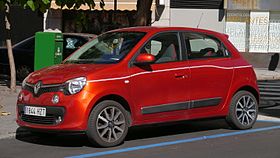 | |
| Overview | |
| Production | 2014–present |
| Assembly | Slovenia: Novo Mesto (Renault Slovenia) |
| Designer | Csaba Wittinger[20] |
| Body and chassis | |
| Body style | 5-door hatchback |
| Layout | Rear-engine, rear-wheel-drive[21][22] |
| Related | Smart Forfour Smart Fortwo |
| Powertrain | |
| Engine | 0.9 L M281 I3 turbo (petrol) 1.0 L M281 I3 (petrol) |
| Transmission | 5-speed manual 6-speed dual-clutch[23] |
| Dimensions | |
| Wheelbase | 2,490 mm (98.0 in) |
| Length | 3,590 mm (141.3 in) |
| Width | 1,640 mm (64.6 in) |
| Height | 1,550 mm (61.0 in) |
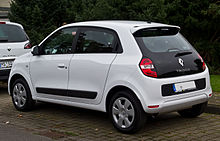

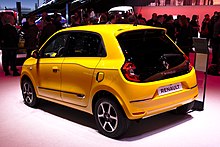
The third generation Renault Twingo debuted in March 2014 at the Geneva Motor Show[24] in a five-door,[25] rear-engine, rear-wheel-drive layout,[22] co-developed with Daimler's third generation Smart Fortwo[26] and second generation Smart Forfour. The third generation Twingo and second generation Forfour are manufactured at the same factory in Novo Mesto, Slovenia.[22]
The third generation Twingo entered into production in May 2014 at Novo Mesto[27] and was launched into the European market in September.[28]
Design and development
In March 2010, Renault and Daimler, as part of their existing partnership, announced "Project Edison", a collaboration aimed at conceiving a shared platform for small city cars to be shared by both companies.[29][30]
The first cars using the platform were the third generation Twingo and the second generation Smart Forfour. Renault and Daimler invested equally during the research and development phase, with Renault subsequently specializing in the engines and Daimler in transmissions.[31]
Both companies tried to ensure a distinctive design. Renault designers took inspiration from the Renault 5.[20] and the first generation Twingo,[32] The car was originally launched with four colour options, as with the original Twingo.[33]
Technical details

The Twingo III is about 10 mm shorter than the Twingo II.[34] The rear engine layout improves the maneuverability and the cabin space, but reduced the boot capacity.[28] The suspension is composed by MacPherson struts on the front axle and a De Dion tube on the rear.[28] The car uses a five-door architecture, which differs it from its three-door predecessors.
Brakes are ventilated disks on the front and drums on the rear, except in the base model (SCe 70) which uses drum brakes all round.[34] The bonnet features a special opening mechanism and allows only partial opening to give access to the windscreen washer fluid, brake fluid and coolant reservoirs, and to the battery.[35]
Equipment
The car originally offered four trim levels: Expression, Play, Dynamique and Dynamique S with various customization packs. One option connects a smartphone with an instrument panel cradle (R&Go) and has an infotainment system (R-Link).[28] Other levels such as the "Energy" trim have since been added. The GT model arrived in November 2016.
Safety
As standard, the car incorporates tyre pressure sensors, seatbelts reminders, four airbags and four head and chest side airbags.[34] It achieved a four star Euro NCAP test rating in 2014.
| Test | Points | % |
|---|---|---|
| Overall: | ||
| Adult occupant: | 30 | 78% |
| Child occupant: | 40 | 81% |
| Pedestrian: | 25 | 68% |
| Safety assist: | 7 | 56% |
Engines
The car originally came with two three-cylinder petrol engines. A 0.9 litre turbocharged unit and a 1-litre atmospheric. Both are fitted low and in a 49 degree angle to increase boot's capacity.[34][37][38] In November 2016 a more powerful version of the petrol engine, the TCe 110, arrived for the sporting Twingo GT model.
| Engine | Code | Displacement | Power | Torque | Top speed | 0-62 mph | Combined consumption | CO2 emissions |
|---|---|---|---|---|---|---|---|---|
| Petrol engines | ||||||||
| SCe 70 | H4D 400 | 999 cc | 52 kW (71 hp) at 6,000 rpm | 91 N⋅m (67 lb⋅ft) at 2,850 rpm | 151 km/h (94 mph) | 14.5 s | 4.5 l/100 km (63 mpg‑imp) | 105 g/km |
| SCe 70 Stop & Start | H4D 400 | 999 cc | 52 kW (71 hp) at 6,000 rpm | 91 N⋅m (67 lb⋅ft) at 2,850 rpm | 151 km/h (94 mph) | 14.5 s | 4.2 l/100 km (67 mpg‑imp) | 95 g/km |
| Energy TCe 90 Stop & Start | H4Bt 401 | 898 cc | 66 kW (90 hp) at 5,500 rpm | 135 N⋅m (100 lb⋅ft) at 2,500 rpm | 165 km/h (103 mph) | 10.8 s | 4.3 l/100 km (66 mpg‑imp) | 99 g/km |
Advertising
In February 2014, Renault organised a "strip tweet" online event to promote the Twingo III. The manufacturer commissioned to Publicis the conception of the car's European advertising. Publicis hired French artists and animators Olivier Kuntzel and Françoise Deygas for the design of the visual campaign[39] with the theme "Go Anywhere, Go Everywhere."[40]
In 2015, Renault released a short music video, "All new Twingo : Show me a car !", in which a twee styled woman is searching a nifty car.[citation needed] It ends with a reference to "Papa & Nicole" adverts for the Renault Clio : "Papa! – Nicole? – Your seatbelt!". The brief video got a viral success in the United Kingdom, with approximately 300,000 views in four weeks.[citation needed]. A Pop Up Store was opened at the Cremerie de Paris.[41]
Bēhance produced Life Designed software as part of Twingo launch.[42]
Reception and awards
In the United Kingdom, the new Twingo won the "City Car of the Year" 2014, TopGear Magazine Awards, "City Car of the Year" in the UK Car of the Year Awards and "Best City Car" in the Daily Express 2014 Motoring Oscars, "Best City Car" at the 2015 British GQ Car Awards.
Paul Horrell of Top Gear Magazine gave the car a score of seven out of 10, calling it: "a genuinely different approach to design and engineering that has brought real dividends, not just in being different for its own sake. Most important, it's much more fun than a base model supermini for the same cash."[43] Auto Express and its sister publication CarBuyer scored it four out of five stars, praising its maneuverability, design, and rear passenger space but criticizing its wind noise and high price compared to its rivals.[44][45] What Car? gave the car three out of five stars, saying: "The Renault Twingo mixes cheeky retro styling with genuine practicality. It’s neither as refined nor as comfortable as the best city cars, though."[46]
Concept cars
The third generation Twingo was previewed through two concepts, the Twin'Z and the Twin'Run.[33]
Twin'Z
| Renault Twin'Z | |
|---|---|
 | |
| Overview | |
| Manufacturer | Renault |
| Production | 2013 (Concept car) |
| Body and chassis | |
| Class | City car (A) |
| Body style | 5-door hatchback |
| Layout | Rear-engine, rear-wheel-drive |
| Powertrain | |
| Engine | Electric motor |
| Dimensions | |
| Wheelbase | 2,490 mm (98.0 in) |
| Length | 3,590 mm (141.3 in) |
| Width | 1,640 mm (64.6 in) |
| Height | 1,550 mm (61.0 in) |
The Twin'Z is a city car concept unveiled in April 2013. Its styling was created in partnership with British designer Ross Lovegrove. According to Renault's chief designer Laurens van den Acker, the purpose of its introduction was to "break down the boundaries between the world of an object whose calling is to be in movement, the automobile, and that of furniture." The concept has a rear-engine, rear-wheel-drive layout and is powered by an electric motor with a 67 hp (49 kW) power output and torque of 167 lb⋅ft (226 N⋅m). It has no B-pillar or dashboard and its doors open in conventional doors up front and suicide doors in the rear.[47]
Twin'Run

The Twin'Run is a rear wheel drive hot hatch concept developed by Renault with assistance of Tork Engineering and Poclain Véhicules, unveiled in May 2013. It is powered by a mid-mounted V6 engine with 320 hp (235 kW), coupled to a twin clutch six speed sequential gearbox and limited slip differential. It has double-wishbone independent suspension on both axles. The chassis is a tubular steel frame inspired by the Mégane Trophy and Renault 5 Turbo Maxi from WRC.[48][49]
References
- ^ "Twist, Swing and Tango — it's the new Renault Twingo". MotorTorque.com.
- ^ a b "Renault Twingo 1 (1992): design history". Car Body Design. 21 March 2007.
- ^ Meiners, Jens (6 January 2014). "20 years on, Patrick Le Quément exposes the political battles and design decisions behind the Renault Twingo". Car Design News. Archived from the original on 6 October 2014. Retrieved 2 October 2014.
{{cite web}}: Unknown parameter|deadurl=ignored (|url-status=suggested) (help) - ^ "ECO 2000 - Citroenet". Retrieved 7 January 2010.
- ^ "Uruguay es interesante para la producción de autopartes y de vehículos". Espectador.com. 14 March 2007. Archived from the original on 15 February 2012.
{{cite web}}: Unknown parameter|deadurl=ignored (|url-status=suggested) (help) - ^ "Historic Models - Renault Twingo". Renault.com. Archived from the original on 29 October 2013. Retrieved 22 November 2012.
{{cite web}}: Unknown parameter|deadurl=ignored (|url-status=suggested) (help) - ^ "2010 Registration document" (PDF). Renault.com. 18 April 2011. Archived from the original (PDF) on 5 April 2012.
{{cite web}}: Unknown parameter|deadurl=ignored (|url-status=suggested) (help) - ^ "Roadcars - Twingo Renaultsport". Renaultsport.co.uk. Archived from the original on 29 December 2010. Retrieved 9 October 2010.
{{cite web}}: Unknown parameter|deadurl=ignored (|url-status=suggested) (help) - ^ "The Renault Twingo RS is dead". Top Gear. 1 August 2013. Retrieved 1 August 2013.
- ^ "Renault previews new Twingo ahead of world debut". Renault.co.uk. 28 July 2011. Archived from the original on 30 September 2011. Retrieved 20 September 2011.
{{cite web}}: Unknown parameter|deadurl=ignored (|url-status=suggested) (help) - ^ "First pic: new Twingo preview". Top Gear. 28 July 2011. Retrieved 7 August 2011.
- ^ "How Belfast Bent Over Backwards for ''Top Gear''". Belfast Telegraph. 10 October 2009. Retrieved 12 December 2010.
- ^ "''Top Gear'', Belfast and a Renault Twingo". CarsUK.net. 6 December 2009. Retrieved 12 December 2010.
- ^ "'Parkers New Car Awards". Parkers.co.uk. 16 March 2011. Archived from the original on 21 March 2011.
{{cite web}}: Unknown parameter|deadurl=ignored (|url-status=suggested) (help) - ^ "Pzaz Limited Edition". Renault.co.uk. Archived from the original on 30 September 2011. Retrieved 20 September 2011.
{{cite web}}: Unknown parameter|deadurl=ignored (|url-status=suggested) (help) - ^ "Twingo Renaultsport 133". Renaultsport.co.uk. Archived from the original on 29 September 2011. Retrieved 20 September 2011.
{{cite web}}: Unknown parameter|deadurl=ignored (|url-status=suggested) (help) - ^ "MZine Miss Sixty". Miss Sixty. Retrieved 24 October 2011.
- ^ "Renault Twingo RS Red Bull edition". Dennis Publishing Ltd. Retrieved 11 February 2013.
- ^ "Renault Twingo". Euro NCAP. Retrieved 7 September 2007.
- ^ a b Kew, Oliver (21 June 2014). "New Renault Twingo vs classic Renault 5". Auto Express. Retrieved 2 October 2014.
- ^ "Interactive video of the New Twingo 2014". renault.co.uk.
- ^ a b c Hilton Holloway. "New Renault Twingo spotted". autocar.co.uk.
- ^ "New transmission of Twingo 3".
- ^ "GENEVA SHOW: World premieres [final list]". just-auto.com.
- ^ "Next Renault Twingo to Only Be Available as a Five-Door - Carscoops". carscoops.com. 26 June 2013.
- ^ Mihnea Radu. "Spyshots: All-New Renault Twingo Spotted for First Time, Looks Like Twin'Run Concept". autoevolution.
- ^ "Revoz launches production of new Renault Twingo". sloveniatimes.com. The Slovenia Times. 8 May 2014. Retrieved 2014.
{{cite web}}: Check date values in:|accessdate=(help) - ^ a b c d English, Andrew (29 August 2014). "Renault Twingo first drive". telegraph.co.uk. Telegraph Media Group. Retrieved 1 October 2014.
- ^ Kable,Greg (30 March 2010). "Daimler, Renault are set to share vehicle platforms and engines". Autoweek. Retrieved 2014.
{{cite magazine}}: Check date values in:|accessdate=(help) - ^ "Daimler-Renault deal confirmed". Autocar. Retrieved 2 October 2014.
- ^ Ducamp, Pauline (4 September 2014). "Nouvelle Twingo : entre Renault et Daimler, qui fait quoi ?" [New Twingo: Renault and Daimler, who does what?] (in French). L'Usine nouvelle. Retrieved 2 October 2014.
- ^ Vautier, Maya (6 March 2014). "Geneva 2014: meet the designers behind new Twingo". Renault. Retrieved 2 October 2014.
- ^ a b "New Twingo: Renault's fresh take on its popular city car". Renault. 14 February 2014. Retrieved 2 October 2014.
- ^ a b c d "New Twingo brochure" (PDF). Renault UK. Retrieved 3 October 2014.
- ^ "RENAULT TWINGO 2016 3.G Owners Manual". www.carmanualsonline.info. Retrieved 19 March 2017.
- ^ "Euro NCAP results for Renault Twingo" (PDF). euroncap.com. 2014.
- ^ "Renault Twingo review". Auto Express. Retrieved 3 October 2014.
- ^ Holloway, Hilton (28 August 2014). "Renault Twingo TCe 90 Dynamique first drive review". Autocar. Retrieved 3 October 2014.
- ^ Arnulf, Sylvain (29 August 2014). "Renault s'offre une signature prestigieuse pour la campagne pub de la nouvelle Twingo" [Renault signs a prestigious advertising firm for the New Twingo campaign] (in French). L'Usine nouvelle. Retrieved 3 October 2014.
- ^ "Tiny Twingo makes a massive statement". The Stable. Retrieved 3 October 2014.
- ^ "Renault Twingo Pop Up Store". Cremerie de Paris.
- ^ "Behance". www.behance.net.
- ^ Horrell, Paul. "Renault Twingo Driven". Top Gear magazine. Retrieved 6 November 2014.
{{cite magazine}}: Italic or bold markup not allowed in:|magazine=(help) - ^ "Renault Twingo review". Auto Express. 16 October 2014. Retrieved 6 November 2014.
- ^ "Renault Twingo". CarBuyer. Retrieved 6 November 2014.
- ^ "Renault Twingo Hatchback Review". What Car?. Retrieved 6 November 2014.
- ^ Horncastle, Rowan (8 April 2013). "Renault unveils the Twin'Z concept". topgear.com. Retrieved 3 October 2014.
- ^ "Renault unveils Twin'Run concept". topgear.com. 24 May 2013. Retrieved 5 October 2014.
- ^ Bond, Paul (24 May 2013). "Renault Twin'Run revealed". Auto Express. Retrieved 5 October 2014.
External links
- Official website (UK)




